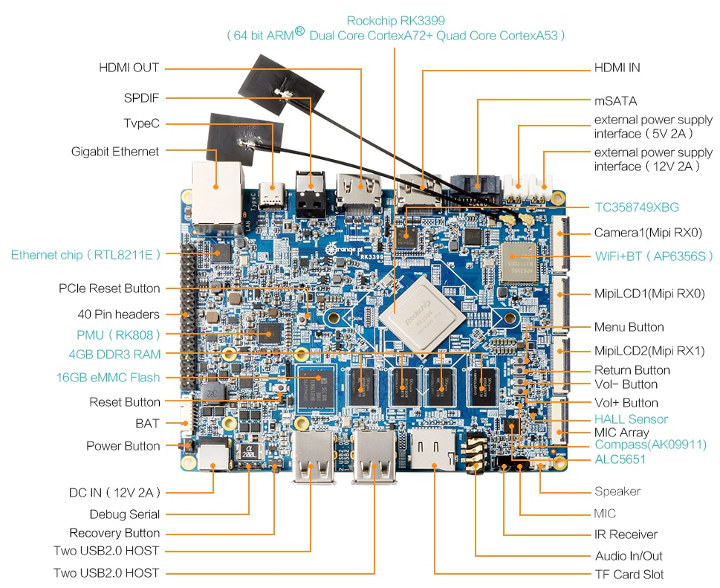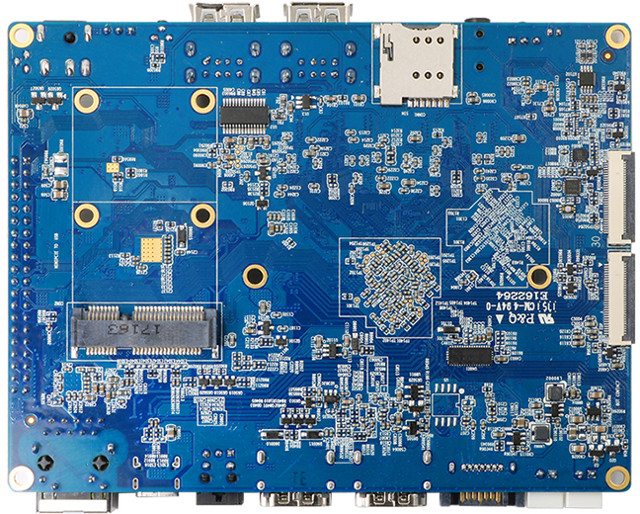Orange Pi RK3399 development board launched last year, further crowding the RK3399 space. The board did not target the lower end of the market with a $109 price tag, but still came with only 2GB of RAM. Shenzhen Xunlong has now introduced a 4GB RAM version of the board for $99.96, with the 2GB version now selling for $89.38. Both boards can be purchased on Aliexpress.

Apart from the RAM capacity, Orange Pi RK3399 “4G” specifications have not changed:
- SoC – Rockchip K3399 hexa-core big.LITTLE processor with two ARM Cortex A72 cores up to 2.0 GHz, four Cortex A53 cores, and an ARM Mali-T860 MP4 GPU with support for OpenGL 1.1 to 3.1 support, OpenVG1.1, OpenCL, and DX 11
- System Memory – 4 GB DDR3
- Storage – 16 GB eMMC flash, micro SD card, mPCIe (for mSATA/LTE), and SATA interface
- Video Output/Input & Display Interfaces
- 1x HDMI 2.0 up to 4K @ 60 Hz
- 1x DisplayPort (DP) 1.2 interface up to 4K @ 60Hz (via USB type C port?)
- 2x MIPI DSI interface up to 2560×1600 @ 60 Hz
- 1x eDP 1.3 (4-lanes @ 10.8 Gbps)
- 1x HDMI input port
- Video Decode – 4K VP9 and 10-bit H.265 video codec support up to 60 fps
- Audio
- Digital audio output via HDMI or DisplayPort
- 3.5mm combo jack with stereo audio output and mic input
- 1x optical S/PDIF
- 1x speaker header (1.5W 8Ω or 2.5W 4Ω)
- 1x on-board microphone
- 1x microphone array interface
- 1x I2S output and input interface up to 8 channels
- Connectivity – Gigabit Ethernet port (via RTL8211E transceiver), dual-band 802.11ac 2×2 MIMO WiFi and Bluetooth 4.1 LE (AP6356S module)
- USB – 4x USB 2.0 host ports, 1x USB 3.0 type C port
- Camera – 2x MIPI CSI interfaces up to 13MP for each interface
- Sensors – Gyroscope+G-Sensor (MPU6500), Gyroscope (LSM6DS3), HALL Sensor (HAL248TWCL), Light Sensor (CM32181), and Compass (AK09911)
- Debugging – 3-pin serial header
- Expansion
- 40-pin GPIO 2.54mm pitch female header with 4x I2C, 1x SPI, 2x UART, 5x GPIO, etc…
- 1x mini PCIe for LTE (USB) or mSATA
- SIM card slot
- Misc
- IR receiver
- 2x power status LEDs (red and green)
- 1x SATA power status LED (green)
- Buttons: reset, power, recovery, menu, return, vol+ and vol-
- Power Supply
- 12V/2A via DC jack (5.5/2.1mm) or 2-pin header
- 5V via type C port or 2-pin header
- Dual battery support (7.4V)
- RK808 PMU, BQ25700 Charger IC, CW2015 Fuel Gas
- Dimensions – 129 x 99 mm
- Weight – 99 grams

Software-wise you’ll find Android and Ubuntu/Debian desktop/server images that have last been updated in February / March of 2018 on the download page, as well as the Android SDK and Linux source code. The community appears to have focused on lower-cost RK3399 boards such as NanoPi NEO4 or Rock64Pro, and for example, there’s no Armbian image for the Orange Pi RK3399 board, even one suitable for testing (WiP).

Jean-Luc started CNX Software in 2010 as a part-time endeavor, before quitting his job as a software engineering manager, and starting to write daily news, and reviews full time later in 2011.
Support CNX Software! Donate via cryptocurrencies, become a Patron on Patreon, or purchase goods on Amazon or Aliexpress




